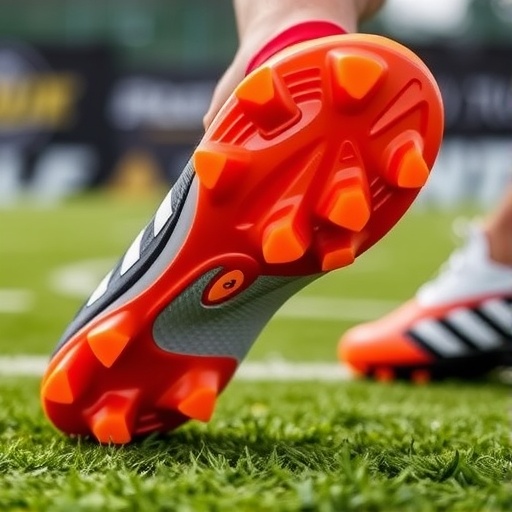
In the world of sports engineering, the optimization of equipment can spell the difference between victory and defeat. Recent research conducted by Lee, Harland, and Roberts delves deep into a critical aspect of football, focusing on the functional properties of football boot outsoles during the shape optimization process. This transformative study provides insights that may pave the way for designing boots that enhance player performance, comfort, and overall on-pitch efficacy. As football continues to evolve into a highly technical sport, examining the interplay between design and functionality becomes increasingly essential.
The study’s primary objective is to investigate how various functional properties of football boot outsoles are interdependent and how these relationships can inform the optimization process. Football boots must provide players with excellent grip, stability, comfort, and propulsion; however, achieving these features often involves trade-offs that can hinder performance. Lee and his team embarked on a quest to understand how different design parameters interact with these functional requirements, ultimately aiming to create a boot that minimizes compromise.
One of the foremost challenges in football boot design lies in achieving the right balance among various functional properties. For instance, a boot designed for exceptional grip may sacrifice comfort, while one that maximizes comfort might not provide adequate lateral support. The researchers employed advanced modeling techniques to analyze these functional properties and their interactions systematically. By using sophisticated algorithms, they were able to generate a broad spectrum of design simulations that enabled them to assess the viability of various configurations meticulously.
Importantly, the research’s foundation relies on understanding how these functional properties affect each other. For example, traction—crucial for quick lateral movements—can influence both stability and comfort, which are equally necessary for maximizing performance on the field. The team’s investigations revealed that specific design adjustments made to optimize one attribute could inadvertently affect others. This interdependence underscores the challenge faced by boot manufacturers and designers: striking the right balance in a multi-faceted design landscape.
The methodology employed in the study showcases a rigorous approach to optimization, utilizing data-driven techniques that can have far-reaching implications. The researchers conducted a series of experiments where they manipulated design parameters and measured the subsequent changes in functional properties. They collected data on variables such as outsole geometry, material composition, and stud placement to determine how these factors impacted overall performance. Their findings suggest that there are indeed optimized configurations that can enhance several performance metrics without sacrificing others.
Moreover, the implications of this research extend beyond the design room. By providing empirical evidence on the interdependence of boot properties, the findings can influence how footwear brands communicate product benefits to consumers. Brands looking to differentiate themselves in a saturated market can leverage these insights to market boots that promise an optimal blend of performance attributes.
The thorough assessment process revealed intriguing patterns in design optimization. Some configurations consistently performed better across multiple metrics, suggesting that certain fundamental principles underpin successful football boot design. For instance, the study hinted at the possibility of a design blueprint that can universally enhance player performance regardless of individual playing styles or positions on the pitch. This finding could revolutionize how football boots are classified and marketed.
Additionally, the team hypothesized that the industry might soon see a move towards more customizable or modular football boots. As players become more aware of how specialized design affects their performance, the demand for tailored footwear is likely to rise. The concept of adaptability in sports equipment, particularly in football, is gaining traction, and these findings could serve as a catalyst for manufacturers to explore new business models.
As with all research, there are limitations and areas for further exploration. The study primarily focuses on a limited set of variables and designs and may not account for all the nuances that differ among players and playing conditions. Future investigations might look to expand the dataset to include variables such as player weight, foot morphology, and environmental conditions during play. These additional factors could yield an even richer understanding of how to optimize boot design for various scenarios.
In conclusion, the work of Lee, Harland, and Roberts represents a significant stride in sports engineering, emphasizing the importance of multidisciplinary approaches in tackling complex design challenges. By elucidating the intricate relationships among design features, this research not only advances the field of football boot production but also sets the stage for further innovations that could enhance athletic performance across disciplines. Their findings could inspire the next wave of technological advancements in sporting footwear, underscoring the vital role that research and development play in the realm of competitive sports.
As this study garners attention within both academic and commercial realms, the potential for impact is great. The intersection of sports, technology, and research can lead to breakthroughs that better serve athletes and, in turn, transform the sport itself. Therefore, the results of this study could represent just the beginning of a new chapter in sports engineering, one where data and design coalesce to redefine excellence on the football field.
Subject of Research: The interdependence of functional properties of a football boot outsole during the shape optimisation process.
Article Title: The interdependence of functional properties of a football boot outsole during the shape optimisation process.
Article References:
Lee, J.R., Harland, A., Roberts, J. et al. The interdependence of functional properties of a football boot outsole during the shape optimisation process.
Sports Eng 27, 29 (2024). https://doi.org/10.1007/s12283-024-00464-6
Image Credits: AI Generated
DOI: 10.1007/s12283-024-00464-6
Keywords: Football, boot design, functional properties, performance optimization, sports engineering.
Tags: football boot design challengesfootball boot outsole optimizationfunctional properties of football bootsgrip stability and comfort in footwearinterdependence of boot featuresoptimizing player efficacy in footballplayer performance enhancementshape optimization in sports footwearsports engineering researchtechnical advancements in football geartrade-offs in sports equipment designtransformative football boot technologies




